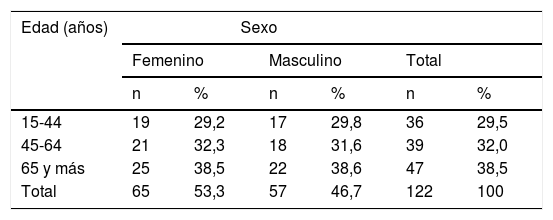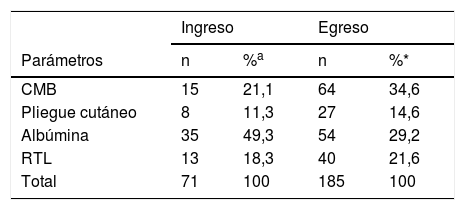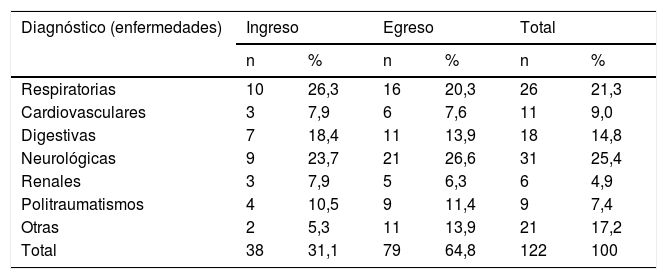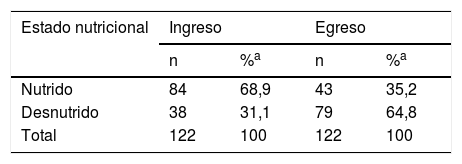Describir el estado nutricional de los pacientes al ingreso y al egreso y determinar los factores con mayor carga predictiva de desnutrición a los que se exponen los enfermos.
Material y métodosSe realizó un estudio descriptivo, aplicado y explicativo en 122 pacientes que ingresaron en el Servicio de Cuidados Intensivos e Intermedios del Hospital Provincial Docente Clínico-Quirúrgico «Saturnino Lora» de Santiago de Cuba, desde marzo de 2011 hasta agosto de 2015. Se realizó un perfil nutricional, el cual incluyó indicadores antropométricos, bioquímicos e inmunológicos, y de acuerdo con los resultados de estos indicadores los enfermos se clasificaron en desnutridos y nutridos.
ResultadosReflejaron que la edad entre 65 y más años fue la predominante, con el 38,5%; a su llegada al servicio el 49,3% de los pacientes presentaron albúmina alterada; de 89 ventilados, 71 estaban desnutridos al egreso. El diagnóstico de enfermedades neurológicas fue el perfil predominante en esta investigación y el período de ingreso entre 7 y 14días fue el que mayor número de pacientes tuvo, con el 56,6%.
ConclusionesLa desnutrición afectó a la mayoría de los pacientes graves al momento del egreso, aunque se encontró cierto grado de desnutrición en el momento del ingreso. Esta entidad predominó en pacientes ventilados, con estadía hospitalaria prolongada con apoyo nutricional mixto fundamentalmente, destacando que la estadía mayor de 10días y el tratamiento quirúrgico sobre el tubo digestivo fueron los factores predictivos con mayor efecto desfavorable sobre el estado nutricional de los enfermos.
To describe the nutritional state of patients on admission and at discharge, in order to determine the factors with a higher predictive weight of malnutrition predictive factors to which the patients are exposed.
Material and methodsA descriptive, applied and explanatory study was carried out on 122 patients admitted into the Intensive Care and Intermediate Care Departments of the Saturnine Clinical-surgical Educational Provincial Hospital Lora of Santiago, Cuba, from March 2011 to August 2015. A nutritional profile was carried out, which included anthropometric measurements, and biochemical and immunology parameters were determine, and in accordance with the results obtained, the patients were classified into malnutrition and nourished.
ResultsThe age group of 65years and over was the predominant one with 38.5%. On their arrival in the departent 49.3% of the patients had an abnormal albumin, 89 were ventilated, and 71 were under-nourished on discharge. The diagnosis of neurological illness was the predominant profile in this study. The length of stay varied 7 and 14days for 56.6% of the patients.
ConclusionsMalnutrition affected most of the seriously ill patients at the time of their discharge, expenditure, although there was certain degree of malnutrition at the time of admission. This condition prevailed in ventilated patients, with a longer hospital stay, with basically a mixed nutritional support. It is noted that a hospital stay longer than 10days and surgical treatment on the alimentary canal were the factors that predicted a more unfavourable effect on the nutritional state in the patients.
Artículo
Socios de la Asociación de Medicina Crítica y Cuidado Intensivo
Para acceder a la revista
Es necesario que lo haga desde la zona privada de la web de la AMCI, clique aquí
Comprando el artículo el PDF del mismo podrá ser descargado
Precio 19,34 €
Comprar ahora

















